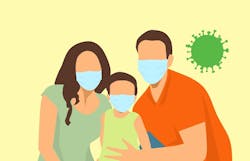COVID-19 model compares effectiveness of vaccine and mitigation strategies
Predicting the spread of COVID-19 using standard statistical models has its challenges, which is why two Iowa State University researchers developed a network-based approach to look at the impact of specific policies and vaccination strategies throughout the many stages of the pandemic, according to a press release from the university.
Claus Kadelka, an Assistant Professor of Mathematics; and Audrey McCombs, a graduate student in statistics, first started working on this issue in March.
“Rather than try and predict something that really can’t be predicted given the uncertainty in the data, we developed an abstract model to compare different scenarios in a qualitative way to see which one gives us the best outcome, irrespective of the underlying uncertainty in all the key virus and disease parameters,” Kadelka said.
In a paper, published on medRxiv prior to peer review, the researchers used their social-interaction network model to understand how homophily – the tendency to associate with people who share the same opinions and beliefs, in this case about COVID-19 – affects the probability of an outbreak and the number of deaths. The model compares the probability of an outbreak for different levels of homophily and correlations among beliefs about vaccination and social distancing. Kadelka said they kept the same proportion of individuals with positive beliefs in all scenarios to provide an apples-to-apples comparison.
The model showed that the presence of homophily can have a strong influence on the probability of an outbreak. Homophily regarding vaccination implies there are clusters of vaccinated, but also clusters of unvaccinated individuals. The researchers found that such homophily in social interaction networks can lead to substantially more frequent outbreaks, especially in the presence of an effective vaccine.
“Standard models assume people’s social connections are random, which we know is not true,” McCombs said. “Modelling more realistic social patterns led to worse outbreaks and higher mortality than what standard models predict.”
They also found outbreaks occurred more frequently when there was a positive correlation between beliefs about vaccination and social distancing. If individuals who get the vaccine are the same people who are more likely to social distance, there is a percentage of the population not taking any protective measures, increasing the risk of an outbreak.
When there is a negative correlation – people get the vaccine, but don’t social distance or people social distance, but don’t get the vaccine – there are fewer outbreaks, because more people are following one of the mitigation strategies. The researchers said their model provides a more realistic assessment of how our interactions and increasing polarization of opinion impact the spread of the virus.

